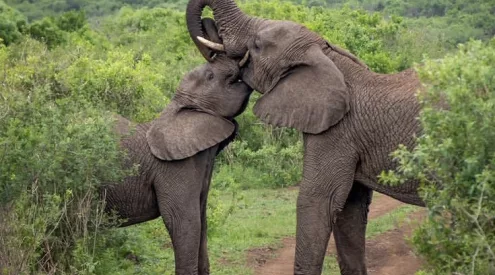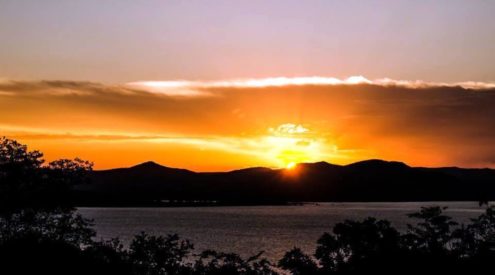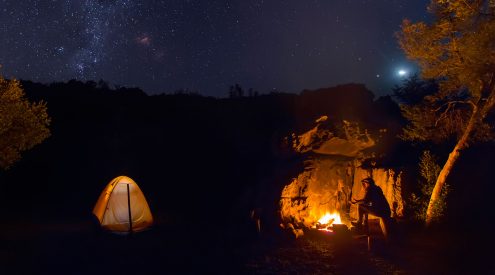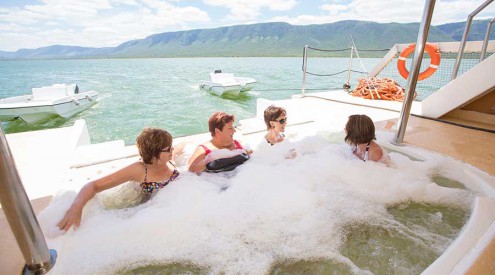My self-drive safari through Botswana, organised through Safari Drive, which saw me exploring Moremi (read my blog about Moremi here) and Savuti (read my blog about Savuti here) promised so much, and delivered more.
Driving west from Savuti we again crossed the sand ridge on the short drive to Linyanti. We got stuck for the first time on the trip as we attempted a hill of thick sand. Reversing up and taking a run at it we were able to push our way through, however talking with other drivers, none made it through, either from Savuti nor from the Chobe direction without having to bring out the shovels. The dry bush road led us to a flooded plain or spectacular beauty. The camp site is next to the river, beyond which are miles of reeds, hiding the many (MANY!) elephants making use of the lush vegetation and constant supply of water.
Game viewing is limited here with a very short game driving road for those not staying in the more expensive lodges, and the ablutions are old, but adequate. However after a week on safari, a day spent in camp reading, playing cards, enjoying the view, and being wary of the frequent camp visitors (including a honey badger that investigated our evening braai), was a welcome change of pace for a day.
And so, onwards to Chobe National Park. Again, the sand can be problematic without the right vehicle, but soon enough you join the tar road that brings you to the gates of northern Botswana’s most visited park. The Ihaha Camp is on the edge of the now largely dry floodplain and offers little shade. In previous years armed raiders crossing over from Namibia have crossed to terrorize campers here but the Botswana authorities have seen fit to post guards at the camp that drive up and down in front of the tents through the night. Needless to say that our stay was peaceful and enjoyable.
As the afternoon light arrived we headed along the Chobe riverfront. The downside to Chobe is the number of vehicles servicing the many lodges and day visitors. The upside to Chobe is the number of vehicles that can be followed to the best sightings. When we heard of lions we immediately set a course, but on arrival found 6 or 7 vehicles clustered together, full of excited tourists over the sight of a lion’s bottom protruding from a behind a tree some 200m from the road. Through binoculars we spotted three more cats, equally hidden. However, some kilometres down the road another lion sighting was much improved. Here, a courting couple lay under a tree in full sight. They moved as one with the mail following every move of his female, and as had happened at Savuti, that move was directly in front of our vehicle.
The light was fading fast and we had quite a distance to get back to camp before curfew, however as we turned onto the road we faced a road block: 2 adult female lions and their 6 sub-adult cubs sprawled across the road. We knew this would be a good excuse to be late so we sat and watched them greet and groom each other for a while before making our way back to camp.
Next morning we left our camp early for a full day’s drive around Chobe. We made our way along the riverfront and were about to head inland but stopped to scan the river ahead. My eagle-eyed colleague spotted movement some distance away and we changed direction to investigate. What we found was a clan of hyena taking advantage of a carcass of a young elephant that we had seen the day before. As the hyenas came and went from the meal table the number of vultures and maribou storks gradually increased. The sun rose higher and the hyenas gradually melted back into the Bush, heading for their dens and prompting the vultures to move in. White-backed, hooded and lappet-faced vultures all scrambled for their share.
We left the scene to investigate a number of vehicles looking intently at a tree which could mean only one thing. Sure enough, picking its way through the branches of a densely foliated tree was a leopard. We spent the rest of the day moving around the area and finding a number of good sightings; a herd of elephant asleep under a tree, a slender mongoose digging insects out of a fallen log and a large herd of sable coming to water to drink under the watch of a troop of baboon. Later in the afternoon we encountered another leopard under a dense thicket and on our drive back to camp, as the light began to fade, we came across a lone male lion on the floodplain. We decided to come back the following morning to see if we could find him again.
Starting out early again we went in search of the lone lion. In the still dim light we made out his form walking out in the open. His walk seemed determined, and in the distance we could see a possible reason why; a herd of buffalo was moving from the floodplain to safer territory amongst the thickets. We kept ahead of him and then there was an unmistakeable moment as he came around a bush and spotted the buffalo up ahead. He immediately lowered his head and stalked forward.
As the sun rose he stealthily made his way towards the herd, and then charged. Unfortunately for us the charge took him behind a bush, but given that the buffalo stampeded out from one side, and he came out the other, we can be assured that his attempts were in vain. He had another go, by which time the buffalo moved far enough away to be out of danger and every other animal in the area was on high alert. We stayed with this chap for a while longer before he disappeared into the forest. Before we left the Park we saw at a distance three more lions, including a female that was considering chasing a kudu or two, but the heat seemed to sap her interest in the effort.
Leaving the Park we checked into our lodgings at the Old House in Kasane. A small and comfortable lodge whose showers allowed us to wash off the dust from many days on safari. Fresh and clean we took an afternoon boat cruise with Pangolin Photo Safaris. Rather than taking the usual tourist boats we booked our places on a specially converted photographic boat. With eight chairs down the middle of the small boat, each that swivel around 360 degrees, and with a good quality camera and 500mm lens fitted to it, the set up was perfect for an afternoon out on the river.
Things were made better by the addition of cold beers, some amazing sightings and a beautiful sunset. Other than my small group, a boat captain and a guide, there were only two other people on the boat – one of which turned out to be the renowned Nat Geo photographer Jason Edwards. It was fascinating to learn of his adventures and watch his skill in action. We had discovered a dead hippo floating along the river, and around it a host of crocodiles waiting for the flesh to ripen before tucking in. Elephants mowed the grass in front of a huge setting sun whilst little bee-eaters gave us a very intimate show as they created the next generation.
So enjoyable was our boat cruise that we decided to forfeit a lie in at our lodge on our final day and went out again on the river. Once more we were met with amazing opportunities to get up close and personal with hippos, crocodiles and birds. We also spent some time with a herd of elephants that were feeding on one of the river’s islands.
And so our visit to Botswana draws to a close. It was an amazing experience sharing good times with friends and watching some of the most beautiful landscapes and creatures that Africa has to offer. I shall return to this stunning place!














































